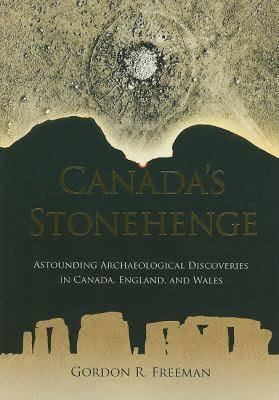Originally published December 2008 | ||
 | ||
Canada s stonehenge
Canada’s Stonehenge (Canada: Kingsley Publishing / Fitzhenry & Whiteside, ISBN 978-0-978-4526-1-2. London: Watkins Publishing, 2012, ISBN 9781780280950) is a 2009 book by Gordon Freeman that claims an archaeological site west of Brooks, Alberta is really a vast, open-air sun temple with a precise 5,000-year-old calendar predating England's Stonehenge and Egypt's pyramids. Datable Sun rise and set observation lines for the Summer and Winter Solstices range from 5200 years ago up to 200–300 years ago. This is not only the oldest accurate calendar ever recorded, it is by far the longest period of continuous use.
Contents
The Sun Temple
Canada's Stonehenge is also known as The Alberta Sun Temple, which can be found in southern Alberta Canada. This temple is very open, and contains an extremely precise calendar that dates back about 5,000 years, which would make it older than Britain's Stonehenge and Egypt's Pyramids. Many archaeologists believe the old stone is just a medicine wheel left behind by early aboriginals. However, Gordon Freeman challenges their assumption in his book by stating that it is actually a 26 square-kilometer stone calendar that marks the changing seasons better than our modern calendar. After 28 years of photographing the site, he was able to discover that the 28 rays that radiate from the central cairn correspond exactly to the length of a lunar cycle. This assures Freeman that the rocks are not just randomly distributed but were actually precisely placed there for a reason.
Stonehenge is megalithic, constructed of extremely large rocks. While The Sun Temple in Alberta is megazonic, constructed of small piles of rocks (cairns) patterned over an extremely large area. Freeman describes the Alberta site as a complex, spider-web‐like pattern of stones extending over an area of about thirty square kilometres. The hilltop centrepiece of the site is a Sunburst image made of stones. Local ranchers have called the Sunburst "the Sundial" for the last hundred years, while archaeologists apply the term "medicine wheel" to this and other constructions across the prairies.
Freeman believed that those rocks and rock piles were "highly engineered," shimmied, balanced, and wedged in ways he couldn't believe were natural. So for the next 28 years, up until his book was published, Freeman would photograph the site in summer and winter, and observer the alignment of the rocks and how they coincided with the recurring patterns of sun, moon and stars. He was able to catalog approximately 12,000 photos into his files with precise times and dates.
The rising and setting sun on both the longest and shortest days of the year lines up precisely with V-shaped sights in the temple's rocks left Freeman convinced that the temple must contain a lunar calendar due to the 28 rays radiating form the central cairn that correspond to the length of the lunar cycle. "I thought I would complete that study in a couple years," says Freeman, a laughing, vigorous 78. "Twenty-eight years later we're still making discoveries."
This structure is also known as a medicine wheel or as sacred hoops. They are built by laying stones in a pattern on the ground, where there is a center made of stone(s), and then surrounding that is an outer ring of stones with lines of rocks creating spokes from the center to the outer ring. Originally, the purpose of a medicine wheel was for rituals, healing, and teaching. Now, these medicine wheels are created in Native American spirituality are referred to as "sacred hoops," with the use of depicting the four cardinal directions. In the United States, medicine wheels can be found in South Dakota, Wyoming, Montana, Alberta, and Saskatchewan.
